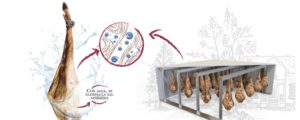A slow and paused curing process allows the pieces to reach an optimal maturation through the window opening and closing system. Not all the pieces are cured in this way, but usually the highest quality Iberian hams follow this process.
Once “las canales” have arrived at the elaboration company, their cutting begins. As soon as the hams and shoulders have been removed from “la canal”, the first step is to remove any traces of internal blood that may be left on both the hams and shoulders, which is called bleeding. Once ready, the following phases will be carried out:
Índice de contenidos
ToggleIt is by profiling that the piece is prepared to begin its curing process. Each piece must be cleaned in such a way that the excess fat is removed and shaped, but without leaving it unprotected. It is important that there are no holes or fissures left that let germs in during the curing process.
Profiling is key and must take into account the morphology of the ham itself and the type of animal that it comes from: 100% Iberian or cross-bred. Each company has a characteristic way of carrying out this profiling.
First the hams will be placed by weight and typology. During this phase the pieces are covered with salt in order to preserve them and encourage dehydration. During salting, the pieces remain in the salting chambers completely covered with salt at controlled temperatures between 0º and 7º C and with a relative humidity of around 70%–90%. The cold helps the salt distribution to be homogeneous.

Each company applies its own salting process, what they all take into account is the weight of the piece and its typology. As a guideline we can say that the pieces usually remain in these chambers one day for each kilo weighed fresh.
Through salting, the colour of the piece is fixed and the aim is to prevent the reproduction of microorganisms that may damage it or alter it.
When the piece enters the salting process, the week and year that this period begins must be known by law. It can be written on the ham’s label, or marked with fire or ink; this is what we call the MAPA of the hams. With this information we will be able to know what cure each ham has.
When the pieces have completed their salting process, they are washed one by one with warm water to remove the adherent salt.
Once cleaned, they are hanged and moved to another chamber: the salt stabilization or settlement chamber. The pieces have to lose dampness little by little until an homogeneous diffusion of the salt between the different muscular groups of the ham is achieved. Here the hams can stay from 30 to 90 days depending on the type of piece. This phase takes place in artificial chambers where both temperature and humidity are controlled. As the days go by, the temperature will gradually rise and the humidity will decrease. The pieces will be prepared for the next phase.
The pieces go to natural dryers equipped with windows that will open or close depending on what the pieces need. In this phase, the climatological characteristics of each area are directly involved.

Drying is a period of rest during which the progressive melting of the fat infiltrated in the piece is encouraged. Its duration varies between 3 and 9 months.
During this phase, the temperature will slowly and progressively increase. Throughout the summer months the exudation of the hams becomes much more acute and intense. The “sweating” of fat during the day is accompanied by concentration and cooling at night.
All the hidden aromas start to emerge gradually and the Iberian ham starts to acquire its characteristic flavour.
From the dryers they go to the cellars, where the pieces start their maturation process. In the cellars the temperature drops again and the relative humidity rises.
During maturation, the ham undergoes a series of enzymatic and biochemical changes which, over time, give the product its excellent qualities of aroma, flavour and texture.
Here, each company, depending on the raw material it has and its own elaboration process, can develop this process in a period of time that goes from 20 months to 4 years.
The elaboration process, together with the breed of the animal, the place where it has been raised and the way it has been fed, are the four aspects that define and differentiate one Iberian ham from another.
Contactar